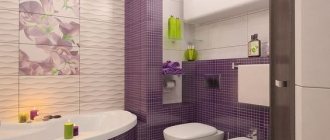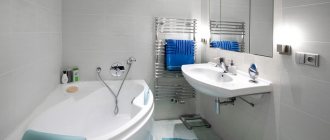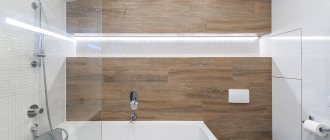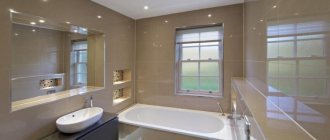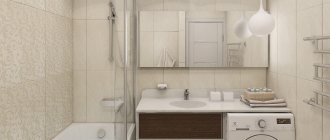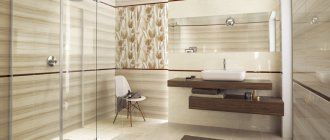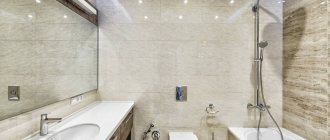Marble is an exquisite and noble material that can decorate any interior, adding luxury and elegance to it. Recently, it has been used in almost all rooms, including the bathroom. Taking into account the subtleties of the selection of materials, marble surfaces can confidently fit into both modern and classic interpretations.
The shades and textures of marble are distinguished by significant diversity, which allows it to be combined with different colors and materials. All external attributes affect the appearance of the interior of marble bathrooms. The overall impression of the room also depends on the main color.
Most often, shelves and countertops have marble coating. You can decorate only part of the interior with the breed, and make a successful combination of materials. This composition will look chic, emphasizing the luxury of the interior.
Large bathroom with gray marble tiles Source stroy-podskazka.ru
The walls and floor are also decorated with marble. To do this, it is better to choose a single color of the breed, and if you want variety, use different cuts of material. The combination of marble on horizontal and vertical surfaces will create a very beautiful and elegant image, the composition will look solid and harmonious.
Expensive marble has a large pattern, so this type of marble should be used to decorate large surfaces - floors or walls.
Marble bathroom design Source www.fashion-mommy.com
If the pattern is not expressed clearly enough, marble tiles in the bathroom can be laid out in a herringbone or mosaic pattern, replacing the direction of the pattern.
In modern interiors it is permissible to use a large amount of marble; literally any element can be decorated with this rock. Plumbing items will look completely different when surrounded by a spectacular stone pattern.
Decorating a bathroom with light marble Source www.azulejosindigar.es
About marble
Natural marble consists of carbonate rocks (limestones, dolomites), which, after recrystallization, increase strength and durability. Particles of marble mineral (calcite) bond together, providing the blocks with resistance to damage. During the crystallization process, the shade of the mineral and the graphic pattern of the marble rock are formed.
By color, stones are classified into white, black, beige, red, pink, yellow, green, and blue.
Do you like marble tiles?
Not really
Artificial or natural
Natural material is durable, high quality, aesthetically pleasing, but has a high price. Manufacturers have developed technologies for producing artificial analogues of stone for finishing premises and architectural compositions.
Materials made from artificial raw materials are classified according to their manufacturing method:
- to flexible;
- for injection molding;
- to oselkovye.
Molding material refers to composite raw materials, which consists of polyester resins, fillers made of crushed quartz, marble and other stones. The composition is optimal for creating sinks, countertops, balusters, sculptural compositions, and window sills.
Oselkovy marble belongs to a subtype of plaster for interior decoration, supplied in the form of a gypsum composition (white or tinted). The material is a liquid raw material with an adhesive base and is poured into a matrix form or applied with a spatula to the wall surface.
Flexible marble is produced in the form of decorative panels. The basis of the raw material is a block of plastic polymer. The outside of the slab is covered with a layer (up to 3 mm) of crushed marble chips, coloring pigments, and epoxy resin.
Budget solution - artificial marble
The high price of marble is a powerful factor limiting the growth of its popularity. Modern technologies have made it possible to create artificial analogues of natural stone. If you can’t buy marble countertops for your bathroom or tiles made from natural materials, you don’t need to give up your dream of a majestic, sophisticated interior. Artificial stone products:
- are much cheaper;
- in terms of aesthetic indicators they are not inferior to their natural analogue;
- do not require complex care;
- have a maximum service life.
Artificial marble is not inferior to its natural counterpart
Many cities now have workshops specializing in the production of artificial stone products. It is possible to order the production of a unique tabletop. You can choose from a range of faux marble tile manufacturers to choose from for your floors and walls.
Disadvantages of marble tiles in the bathroom
Disadvantages of marble tiles for the bathroom:
- the high cost of even artificial analogues that contain natural stone;
- large mass;
- difficulty in laying on the floor or installing on vertical surfaces;
- the need for additional treatment with protective compounds.
Price
Natural material is highly expensive. Artificial analogues also contain mineral components and are 3-5 times more expensive than ceramic slabs. The cost of installation work is affected by the need to purchase additional fixing compounds (mastic, glue, impregnation) for fixing massive blocks.
Careful leveling of surfaces, polishing of ends and complex installation work are required. The joining of marbled blocks must be seamless.
The cost of marble slabs is from 1,500 rubles per 1 m². The price of natural materials is affected by the location of the deposit, delivery costs, processing, cutting, and slab calibration. Experts also evaluate porosity, color, texture and surface pattern.
Special care
Marble products and artificial materials require proper care. The mineral is fragile, contains particles of metal oxides, and therefore requires treatment with a sealant to prevent oxidation and rust.
Regular cleaning of bathroom surfaces is required. It is optimal to use water, soap solution, and a nylon brush for cleaning. Acid-containing products with abrasive particles are not recommended.
Stone and artificial analogues have a porous structure that can absorb contaminants. It is necessary to control the cleanliness of surfaces; it is unacceptable to leave soap solutions and water on the floor. Stones require careful handling and the use of special protective mastics to preserve the structure of the material.
Pipes
For the toilet, be sure to choose a sewer pipe of at least 100 ml. For the rest of the plumbing, you can choose pipes of at least 50 ml. It would be better if they were noise-absorbing.
Polypropylene pipes are inexpensive and easy to install. But all breakthroughs and leaks occur precisely at the junctions of such pipes. The adhesions must be performed flawlessly. With pipes made of cross-linked polyethylene with fittings for crimping, there will be no breakthroughs. But the price will be much higher.
Main advantages
Advantages of marble bathroom tiles:
- aesthetics;
- long service life;
- high strength;
- resistance to temperature changes;
- moisture resistance.
A wide palette of shades and textures allows the material to be used in interior decoration in different directions, to create artistic panels, geometric patterns, and collages.
We also recommend watching - White tiles in the bathroom: features of use and combinations with other tones
Marble countertops
Furniture made from natural stone is a worthy decoration of the interior. Marble countertops for bathrooms are very popular. These products transform the decor, providing it with sophistication and aristocracy. Masonry structures have several distinct advantages. Products:
- have a unique texture;
- have a wide palette of shades;
- have antiseptic properties;
- can be manufactured in any configuration.
Marble countertops add sophistication to the bathroom
Marble patterns are not repeated. Each marble bathroom countertop is a unique piece, which is important for a modern interior. The variety of shades makes it possible to accurately select a product for a specific design. Marble goes well with metal, glass, and wood, which allows craftsmen to combine materials in designs.
High air humidity and high temperatures create excellent conditions for the proliferation of mold spores and putrefactive fungi. The antiseptic properties of marble do not allow microorganisms to develop. A healthy microclimate will be maintained in the bathroom.
Marble maintains a healthy microclimate in the bathroom
This natural material can be cut and processed. Marble countertops for the bathroom can have any configuration and size. According to individual orders, craftsmen will create a design that will fit perfectly into the interior.
In addition to countertops, you can also use shelves in the equipment of the room, and make partitions using this material. You can find many interesting ideas in the photos of marble bathroom designs.
Marble fits perfectly into any interior
Types of marble bathroom tiles
Marble tiles for the bathroom come in the following types:
- floor;
- wall;
- mosaic;
- curly.
Each of them differs in color, design, size and performance characteristics. So, the floor one is much stronger than the wall one and can withstand heavy loads. Standard wall tiles are suitable for decorating large areas, and with the help of figured and mosaic tiles, individual zones in the room are distinguished.
Floor
It is ideal for the bathroom and other rooms with high humidity. The tiles are wear-resistant - their service life is at least 50 years. During this time it does not lose color. Such tiles are not afraid of mechanical damage, they are several times stronger than concrete, so they are difficult to split.
The coating is easy to clean, so bacteria do not accumulate on it. It is also not afraid of high temperatures and moisture. The tiles are made from clay, so they are a hypoallergenic and environmentally friendly product.
Wall-mounted
It has the same characteristics as the floor one, but is less durable. However, marble-effect tiles are often used to decorate walls. It is easy to clean and is not afraid of temperature changes, high humidity and aggressive detergents. This tile does not require frequent cleaning. It has low electrical conductivity, so static electricity does not accumulate on the surface, and dust, hair and fur do not stick.
Buyers are offered a huge range of marble wall tiles. It differs in size, color, texture. In stylish designer interiors, a combination of natural stone tiles of different shades is often found. Combinations can be the most unexpected, for example, snow-white marble is combined with gray or pink.
Mosaic
Marble mosaic will fit into the interior of the bathroom - it has remained a favorite for several seasons. Mosaics are small squares in the same color scheme that differ in shade.
It, like any tile, is not afraid of moisture, high temperature and mechanical stress. Mosaics are used to decorate uneven surfaces, corners, and countertops - this is very convenient, especially if the bathroom has a modest area. The interior will also be decorated with mosaic inserts on the wall. They can be chosen to match the tiles or in a contrasting color.
Curly
White marble in the bathroom looks beautiful, but sometimes it is boring. To give your interior some zest and character, you can use figured tiles. If regular tiles have right angles, then figured tiles have smooth, rounded edges.
This type of tile is more difficult to lay than regular tiles. When laying, a lot of waste remains, so initially you need to buy more of it. There is no need to lay the room from floor to ceiling with figured tiles. You can only decorate a small part of the wall above the bathtub or another noticeable area.
Choosing the right plumbing
Scientists have calculated that the average person spends about two years in the bathroom during their lifetime. And therefore it should be as convenient and comfortable as possible.
First you need to design what items, what quantity and what sizes of plumbing fixtures are needed in your bathroom. In this case, important factors need to be taken into account:
- When planning, keep in mind that nothing built-in or mounted can be placed on monolithic walls and ventilation ducts.
- You cannot move the toilet to the opposite place from the sewer.
- It is imperative to leave accessible space for the sewer inspection brushes.
- If you want to expand the bathroom, you can only do this at the expense of non-residential premises.
- Waterproofing must be laid around the entire perimeter of the bathroom.
Marble tile texture for the bathroom
According to the texture, marble tiles can be of three types:
- matte;
- glossy;
- semi-gloss.
Each of these types has advantages. Glossy reflects light and makes the room more elegant. And matte, on the contrary, absorbs it, due to which the interior becomes more elegant and intimate.
Matte
The big advantage of matte tiles is that they do not require frequent cleaning. It absorbs light, due to which splashes, stains, wool, and dust particles are not visible on it. Small scratches remain unnoticeable on the matte surface, so it is better to lay this kind of tile on the floor. This coating is ideal for the bathroom because even if water gets in, it does not slip.
Manufacturers offer tiles with varying degrees of porosity. If there are too many small holes on the surface, it is difficult to clean. Over time, dirt may become embedded in such tiles, and they will develop a grayish tint.
Glossy
These tiles are recommended for small bathrooms. Due to the fact that light is reflected from the glazed surface, the space visually expands. With glossy tiles, the interior seems brighter and “juicier”. Glossy marbled tiles in black and green colors look impressive.
This material also has disadvantages: the surface is highly slippery, and small scratches and chips are very noticeable on it. This tile is easy to clean, but it needs to be done often, because any dirt on it is clearly visible.
Semi-gloss
If both of the previous options do not suit you, buy semi-gloss tiles for the bathroom. It is slightly shiny, but has a rough surface. This tile does not get dirty as quickly as glossy tiles, but it also does not require frequent washing. It is suitable for both walls and floors of any style interior.
Protecting marble from moisture
Companies protect marble from water absorption already at the stone processing stage. However, it is also worth impregnating it at home with specialized products. Thanks to this, you will be sure that this expensive and beautiful stone will not be damaged during use of the bathroom. After all, it is constantly exposed to water and water vapor.
What do you need to know about impregnating marble?
- Impregnation protects all micropores from moisture penetration.
- Impregnation of marble is carried out at the very beginning of use and is repeated from time to time.
- Impregnation makes the marble more saturated.
- In areas particularly susceptible to water penetration, it is recommended to use a 2 millimeter thick waterproofing membrane.
Which marble tiles should I buy?
The consumer qualities of finishing materials vary depending on the type of surface (walls, floors, decorative items). Manufacturers produce collections for the renovation of all bathroom surfaces and additional accessories (mastics, decorative inserts) in a single color scheme with an identical pattern.
When choosing a material, you must consider:
- accuracy of the geometric shape of products;
- compliance of blocks with standard sizes;
- integrity of raw materials (elements must be free of cracks and chips);
- resistance of surfaces to abrasion;
- resistance to changes in temperature conditions;
- resistance to mechanical loads;
- moisture resistance parameters (up to 20%);
- fastness of color, lines of ornaments;
- anti-slip characteristics for floor slabs;
- best before date.
Choice depending on bathroom parameters
When selecting a material, it is important to take into account the size, style, and performance characteristics of the bathroom. In large rooms you can use different colors, textures, and types of installation. Compositions of marbled blocks in black, chocolate, and emerald shades are possible.
For compact rooms, it is necessary to select colors and textures that visually enlarge the space. It is optimal to decorate the upper part of the room with light-colored slabs; the design of the lower half should match the tone of the floor covering.
When selecting material, it is necessary to determine the method of laying the blocks. The diagonal method requires a larger volume of raw materials than when implementing standard checkerboard masonry.
What color?
The color scheme of natural and artificial blocks for the bathroom should be neutral and comfortable to use.
Light colors will visually expand the room. For compact bathrooms, marble slabs in white, beige, light pink, gray, and soft blue shades are optimal.
Medium-sized rooms can be decorated with marble in mustard, terracotta, and pink shades.
A neutral interior can be created using marble blocks of white, creamy, baked milk, and ivory colors. Accents in the room are made using slabs of golden, red, and turquoise shades.
In a room with good lighting and additional lighting, blue, gray, dark green shades of marble slabs are used.
Using black blocks you can create a stylish interior, but you must take into account the need for additional care and protection of surfaces from scratches. It is not recommended to use dark materials in small spaces.
An impressive design will be achieved by using marble blocks in the same color scheme and with a similar texture. The room will gain volume, surface joints will be smoothed out. It is optimal to combine 3-5 shades in finishing.
What texture and what size?
Marble blocks are produced depending on the processing with different surface textures:
- glossy;
- matte;
- textured.
Glossy surfaces are aesthetically pleasing and add additional volume to the room when creating a lighting system. The material is easy to clean, durable, and effectively reflects light. However, glossy slabs in rich shades can create strong glare.
Matte marble slabs are optimal for eco-style interiors and minimalism. The surfaces are distinguished by muted shades, allowing you to create a comfortable atmosphere. The material is suitable for flooring, because... more secure and wear-resistant.
Textured boards with an artificial composition allow you to reproduce the texture of solid wood, pebbles, and metal surfaces. The blocks are optimal for spacious bathrooms with an additional lighting system. In the Provence style, blocks with aged surfaces and patination are used.
The range of marble tile sizes is represented by standard and non-standard dimensions. For compact rooms, medium-sized blocks are optimal. Large slabs are used in spacious rooms. Common block dimensions are 300x600x20, 305x305x10, 600x600x20 mm.
Distinctive features of marble finishing
Not every owner of a house or apartment can decorate a bathroom with marble. Marble is considered an expensive material, so only lovers of luxury can afford to decorate it.
The most valuable material is the one with small veins. The color scheme has a wide range of shades, including coal black, emerald, red-brown, steel gray, light pink tones.
Choosing a style for a marble bathroom
Marble tiles in the bathroom are used in the interiors of the following areas:
- classic;
- country;
- retro;
- vintage;
- Provence;
- eco style.
When finishing rooms of classical design, marble can be used in the design of floors and walls. Natural material is complemented with golden accessories and fittings. The spacious room is equipped with tabletops, shelves, and stands made of marble.
In a country-style room, the use of marble (natural, artificial) is combined with porcelain stoneware and wood treated with moisture-resistant impregnation. Blocks in brown and mustard colors are recommended.
In the design for vintage and retro styles, light marble tones (pink, lilac) are combined with brown and terracotta colors.
Classical
White, gray or beige marble is suitable for such an interior. It is better to choose tiles with veins - this design is ideal for classics. The floor can be made plain light, or you can combine white tiles with black ones. This combination is always rich and interesting.
For a small bathroom, choose light glossy or semi-gloss tiles - they will make the room seem more spacious.
Part of the wall will be decorated with a panel of figured tiles - its boundaries can be indicated by a golden frame. A white bathtub and copper or gold-plated sanitary ware will suit a classic interior. If space allows, you can install a stone countertop in a contrasting color for the sink - brown, black, dark green. Furniture for such an interior is selected from white, beige or cream-colored wood. It can be decorated with carvings or soft, simple patterns.
Retro
Here you need to choose what kind of retro style the interior will be made in - marble is not always suitable. It is relevant if you make a vintage bathroom, in the style of the 30s, for example. For the later period, the use of natural stone was not typical.
Eco
Only natural materials are used here. For walls and floors, choose natural stone or artificial stone that imitates it. Dull marble will fit very organically into an eco-friendly bathroom. It will go well with natural wood, glass, and green plants. Such rooms are decorated in a restrained color scheme - bright, glossy tiles are not suitable for such rooms.
Artificial marble is often used in bathroom decoration. Its popularity is due to the fact that it looks as beautiful as natural, but costs less and has exceptional performance characteristics. Marble tiles are suitable for decorating not only classic-style interiors, but also many modern ones.
How to choose a stone shade
The excellent decorative properties of marble have determined its use in the bathroom, while the tone of the material determines its characteristics. The most popular colors of the product:
- White marble. This is the most luxurious and majestic shade. May contain gray or beige impurities. This tone will suit any room, but it is especially good to use in small bathrooms.
- Gray color characterizes classic interiors. This is a calm, cool shade that looks really expensive and noble. Can be combined with white color and wooden furniture.
- Dark tones add contrast and expressiveness to the room. You can select several zones as an accent, and in a large room a wall completely decorated in dark shades would look good. If you choose a chocolate color, the overall appearance of the interior will become much warmer and more comfortable.
Bright combined bathroom Source me-house.ru/
Decorating the walls in the bathroom with marble: interesting ideas for the interior
When decorating bathrooms, different types of laying stone blocks can be used. On the floor it is possible to implement the “braid”, “checkerboard”, “versailles”, “herringbone” techniques. An original combination of different textures, shades of marble and the use of tiles, glazed ceramics, and porcelain stoneware in a design project.
Beige marble bathroom design
Beige shades allow you to visually increase the area of the room and create a background for ornaments and collages. In the bathroom you can combine marble blocks of different golden shades. Using a sand range of shades, you can create checkerboard laying on the floor and create accents on the walls.
Accessories in white, terracotta, and orange shades are recommended. It is possible to install wicker furniture and decorative items.
Combination of wood and white marble in the bathroom
In rooms in eco-style and country style, it is optimal to combine white marble and solid wood. Different shades of wood species (birch, wenge, pine) allow you to implement contrasting combinations in the interior. The floor, sink, and countertop should be finished with marble. Wood can be present in the interior as accessories, finishing one wall, or ceiling.
The combination of wood and light marble is used in the Scandinavian style. The direction is distinguished by laconic forms, symmetrical placement of blocks, and the absence of many accessories. Wood species should be of cool shades (brown, ash tones).
Marble bathroom design
When implementing a bathroom project with marble tiles in a minimalist style, it is possible to finish the wall or floor. It is recommended to use neutral combinations of black and white colors. It is important to highlight the beautiful pattern of marble veins with lighting.
When creating a project in the Art Deco style, you can combine contrasting shades of marble. An original design is allowed, creating a podium in the center of the bathroom from blocks. Laying should be carried out with bends and complex patterns. Installations, collages, and panels can be made from marble.
Photo examples of kitchen and dining room design
view album in new window
In the photo: Kitchen set with a mirrored apron and island
A countertop for a kitchen or kitchen island can be made of different materials: agglomerate and corian (which we discussed above), artificial stone, chipboard and MDF, as well as natural marble. There are countertops made of granite and quartzite, and in the most luxurious projects - from onyx, agate, and labradorite. From floor designs to countertops and backsplashes, white is the most popular color in kitchen design. In the kitchen, the marble pattern can also be found in the design of utensils (on cutting boards, tableware and serving utensils, cups, trays).
Stunning fashionable kitchen with emerald splashback and white cabinetry
view album in new window
In the photo: Kitchen with a green kitchen apron and a light countertop
A stunning design move from an accent kitchen apron in an emerald shade in the form of a diagonal design with boar tiles (herringbone pattern, like French parquet).
Luxurious classic kitchen with designer finishes in warm colors
view album in new window
In the photo: Luxurious kitchen with a chocolate apron and countertop
Classic kitchen renovation with large U-shaped cabinetry and pantry cabinets. On the facades there are relief carved wooden parts in gold and gold handles.
Art Deco dining area in a luxury apartment
view album in new window
In the photo: Beautiful dining room decorated with white and black marble (porcelain tiles) and gold accents
A dining area with a claim to a cinematic level of interior. Art Deco style always looks amazing in an open plan.
Dining room in gray tones with black cupboards and dining area
view album in new window
In the photo: Art Deco dining room in black and gray colors
A wonderful example of understated Art Deco chic for the interior design of a formal dining room for 8 people. On the left is the kitchen with a bar counter, on the right is the living room.
Dining area in a small kitchen in ash-stone tones
view album in new window
In the photo: Dining area in the kitchen in a modern style
And in a small kitchen there is a place for unusual decoration and original design solutions! For example, a panel of lamps in the parametric style.
Massive kitchen with varnished wooden fronts
view album in new window
In the photo: Luxurious kitchen with a large set up to the ceiling
Luxurious kitchen interior with built-in furniture and lacquered facades. The finishing of the floor, countertops and apron imitates natural stone of different types.

